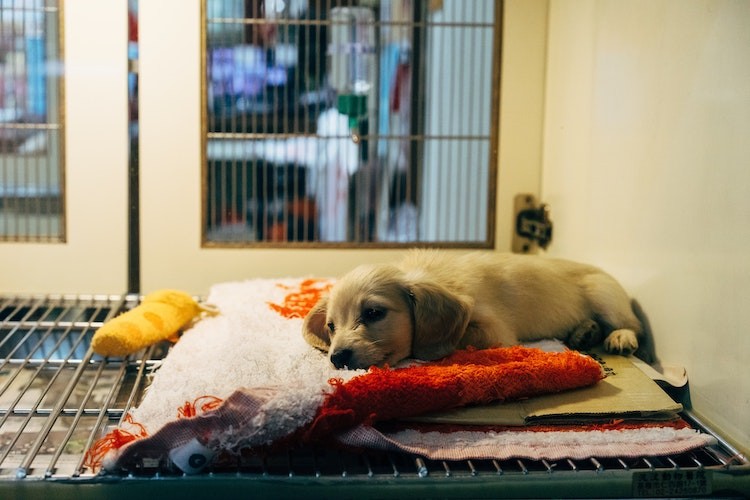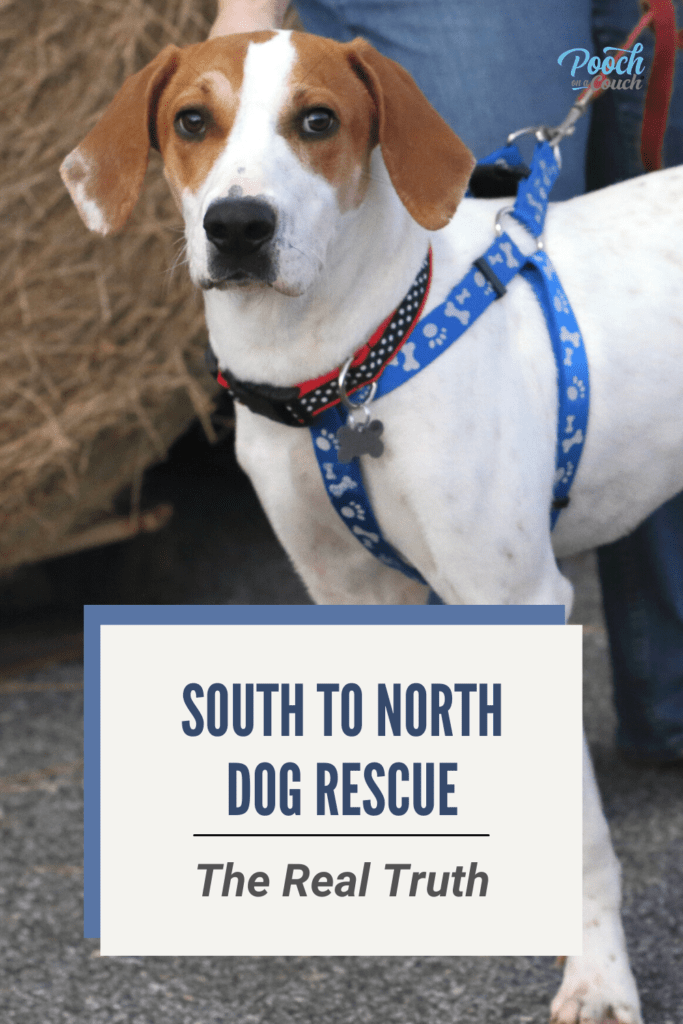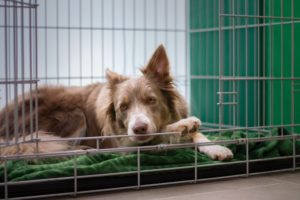August 29, 2005. Hurricane Katrina slammed into the coast of Louisiana causing a domino of catastrophes that displaced (and killed) humans and their pets.
Animal humane societies scrambled to manage the steady stream of dogs and cats arriving at makeshift animal care spaces. Dogs and cats that were plucked off of rooftops, found clinging to floating debris or locked inside buildings made their way to safety.
Prior to the storm’s arrival, humane societies prepared for the worst by tirelessly arranging transport trips to move pets currently residing in Louisiana and Mississippi shelters to other shelters northward in an effort to prepare and make space for the anticipated and massive influx of displaced pets.
Many pets were separated from their owners as pet restrictions prevented dogs from evacuating with their owners. Heartwrenching doesn’t begin to describe it.
The multi-state and multi-agency animal welfare response was huge. Dogs rescued were transported to out-of-state animal welfare agencies with the intention to attempt a reuniting of the pet with the original family. In many cases, reunification never happened and those dogs were placed up for adoption somewhere else in the U.S.
This was the first time I’d ever heard about the “pet shortage” in the north.
Since Katrina, most of my rescue friends somehow participate in transporting southern dogs north where the dogs (and cats) usually have a home waiting for them.
Every month, thousands of dogs from southern states are loaded up on transport vehicles and moved north or to places in the midwest for the promise of a new family.
South to north dog rescue sounds like a wonderful thing.
Dogs Overflowing to Dog Shortages
How are there dogs, dogs, dogs everywhere in the South while there is a dog shortage in the North? Most will tell you that it’s due to stricter laws especially in the northeast. Spay Neuter mandates are everywhere up there and nowhere down here. While stray dogs do exist in the north, there is no comparison to the number of free-roaming dogs in the south.
It isn’t a lack of spay/neuter laws. In fact, our pet overpopulation problem really has little to do with whether or not our pets are intact.
On Being A Southern Pet Owner
I love being a southerner, but I do have to tell you that as a species, we have some pretty bizarre beliefs and values about our dogs.
- Many southerners believe that a male dog should remain intact and ought to be allowed to roam around to “get some” because dogs get frustrated from lack of sex. Ridiculous.
- A hunting dog that “won’t hunt” needs to be terminated. By someone else. Till then, it’s turned loose.
- We poo-poo the warnings given that dogs can mate through a fence. So, we put our female dogs outside while they are in estrus because – geez – the mess is too much to deal with. Then we wonder how the heck she “got knocked up”.
- We believe that good parents must arrange for their children to witness the miracle of birth. So we breed our pet – just once – then discard the litter of 11 puppies because, well, puppies are hard. The second litter happens because well, we were going to get her fixed, but…..
- We are waaaaay too busy to house-train, so our dogs get banished to the outdoors where they get bored and find a way out of the fence.
- And we know that dogs used to be wild animals, able to fend for themselves. So, we find a nice stretch of road adjacent to some woods where we give the dog back to its roots. There’s lots of food in the woods, you know. Domesticated animals never lose their survival instincts, right?
- We believe that dogs need to roam and that they will eventually come back home. Except when they don’t.
- Ironically, even though we believe that dogs need to roam, we are quick to pull out our shotgun when a neighbor’s roaming dog gets into our chickens. It’s just buckshot.
- We believe that our dogs have healthy enough immune systems to fight off disease and parasites and don’t need veterinary care.
No wonder my rescue friends are eager to send dogs as far away from the south as they can. (No offense intended to my dear southerners who are exceptional pet owners. )
So, How Does South To North Dog Rescue Work?
In general, south to north dog rescue is a partnership where a southern rescue agency (or person) selects adoptable dogs from southern shelters, arranges for basic vet care and spay/neuter while coordinating with a northern rescue who will market the dogs, select adopters, and receive the dogs who then go on to their new homes. A third party – the transport service – is chosen to drive the dogs from the south to the north.
Models Of South To North Dog Rescue
There are several models of south-to-north dog rescue. I’ll do my best to explain the differences.
Dogs are fostered in the south then transported to approved adopters in the north.
In this model, a northern rescue group partners with a southern rescue or southern rescuers to select, vet, assess a dog in the south before transporting north.
One southern rescue agency does it this way, twice a month: 14 days prior to transport day, all dogs that have been selected to “go north” will be pulled from shelters, vetted, spay/neutered, and placed into southern foster homes where these families will provide care, observation, and will provide a report/pictures to the north rescue. While the southern family is fostering the dog, the northern rescue agency is working through applications and helping families select their new pet.
When it is time to transport, all dogs are loaded up onto the transport vehicle, get on the road, and drive to the receiving rescue where often, families are already in line waiting for their new dog.
The most successful who use this model have their own independent transport service. Others rely on transport companies with tractor-trailers who transport dogs from a variety of rescues agencies across several states.
Dogs are vetted in the south, cleared, then transferred to northern rescues.
In this model, dogs spend less time in the south and may not spend any time at all in a southern foster home. Instead, a northern rescue wants the dogs in their foster homes or their shelters for assessment. Of course, because USDA transport laws mandate that dogs have a health certificate before crossing state lines, some vetting must be done before a southern dog makes the trip north.
Dogs belonging to southern rescues are transported to their foster homes located in the north.
Some southern rescues want more say in who adopts their dogs. In the above models, it is the northern rescue that makes the placement decisions. In this south to north dog rescue model, the southern rescue agency manages their northern foster homes. The dogs are vetted in the south, cleared to travel, and live in foster homes up north until an approved northern adopter is found.
This is a really good model, I think. The northern foster home is able to be present and a part of the adoption approval process, is there to handle follow-up calls, and is able to retrieve the dog should the adoption fall through for whatever reason.
Anindependent southern rescuer selects the dogs, drives the dogs themselves (or hires a private transporter) where an adopteris waiting for the dog.
Quite a few of my rescue friends do this model. They want to be hands-on with the dog in which they’ve invested time, money, and emotion. Are they saving 100 dogs at a time? Nope. Just one. One at a time.
These friends know the risks associated with agency partnerships and prefer to be a part of every decision in their foster dog’s journey.
Problems With South To North Dog Rescue
Even though many of my rescue friends participate in south to north dog rescue work, I have just as many who refuse to send any of their dogs on transport or release ownership to a northern shelter or rescue organization.
Why? If there are people in the north who are waiting and waiting to adopt a dog and we have too many southern dogs sitting in shelters and private kennels, what’s the problem?
The Problem Of Distance
When we rescue a dog, that dog is part of us for life. I know that to be true. I’ve fostered 50 or so dogs and every one of them is part of my heart.
Because of that emotional connection, some of my friends refuse to adopt their dogs to anyone living outside the southeast, preferring that their dogs remain close by. Should that dog lose its home, for whatever reason, it’s easy to retrieve the dog.
Most rescue adoption contracts have a no transfer clause, meaning that a person cannot rehome an adopted dog but must contact the original rescue agency to return. If I’m in Alabama and I have a dog in Canada, it is difficult and expensive to arrange for safe transport back to Alabama. If you’ve ever had a dog in trouble in a different state, you know the feeling of utter helplessness when you can’t get to your dog.
If the adopting rescue agency is northern, distance isn’t a problem – it is their adoption contract and their dog to retrieve. If it is a southern rescue that has its own roster of foster homes in the north, it may not be difficult to retrieve a dog either.
The problem is, we have that emotional connection, that investment of time, skill, and love, and it is HARD to let it go.
The Problem of Vetting
The USDA has clear rules governing the transport of animals across state lines. On top of these federal rules, some states also have requirements that all rescuers must adhere to when transporting dogs across state lines. If you are arranging for the interstate transport of a dog, you MUST know the current rules for each state. State departments of agriculture update their requirements often.
For example, did you know that Alabama doesn’t allow the introduction of screwworms into the state? I don’t even know what a screwworm is or where a dog might pick up such a worm.
Here’s a quick link to the USDA APHIS site where you can look up your state’s current transport requirements.
For all states, the minimum USDA APHIS requirements for vetting are:
- The Health Certificate – The USDA requires that all dogs for the purpose of resale or research (folks, adoption IS a sale) travel with a health certificate issued by an examining veterinarian no less than 10 days before transport. Some states, like Massechusetts and Connecticut, have very strict timelines for health certificates, so it really does pay to do your homework.
The health certificate states that the veterinarian has examined the dog and determined the dog free from obvious illness or infectious disease and able to travel.
While the USDA APHIS has an online health certificate form, many states are now not accepting the online form. Here is Alabama’s statement from their Department of Agriculture and Industries website:
“Effective January 1, 2019, APHIS form 7001 “United States Interstate and International Certificate of Health Examination for Small Animals” is no longer approved for interstate movement of small animals into Alabama by the Alabama Department of Agriculture and Industries (AGI). Please be aware that numerous other states are no longer accepting the online-only form, due to its free access to the public for downloading off the internet without any accountability as to who uses the form.”
Be sure to check the destination state’s health certificate form requirements as you prepare a dog for interstate transport. - A current Rabies vaccine along with a copy of the signed rabies certificate and the rabies tag with a serial number that matches the certificate.
The AVMA, ASPCA, AAWA, and ASV all have position statement on best vetting practices for the transport of dogs.
I’ve provided the links to each, but all agencies in their own words remind us that rescue transports, (a.k.a. south to north dog rescue) while life-saving missions, do not come without risks. And we as animal welfare agents should do more than the bare minimum of a health certificate and a rabies shot.
The AVMA outlines the risks of interstate transport as
- having the potential to spread infectious disease from origin to new (clean) destinations.
- transport is stressful. Stress can increase an animal’s susceptbility to infection, increase viral shedding, or aggravate behaviors.
- Transports from multiple origins will increase the risk of exposure to infectous disease.
In other words, infections such as Parvo, giardia, coccidia, respiratory all have the potential to spread within the transport vehicle and to destination locations including clean shelters or private pets and humans.
How well does your rescue agency plan for the relocation of southern dogs to northern sources? How thorough is the vetting? What is the contingency plan if a dog tests positive for an illness or condition? Is that foster dog of yours really free from contagious or infectious disease? Are you sure? What’s your evidence?
How To Quarantine Your Foster Dog
The Problem Of Safety and Emotional Well-Being
One of the most well-known south to north rescue transporters is Rescue Road Trips, a transport company out of Ohio. As stated on their website, they take an entire week to drive down from Ohio, through stopping to pick up dogs in several southern states until they get to Texas, then they turn back around through more southern states, picking up more dogs! The end of the trip is on a Saturday where the remaining dogs are offloaded and on their way to a new home.
It is hard for any of my rescue friends to imagine their dog on a trailer rig for nearly a week! What? The noise. The stress. The lack of freedom.
Yes, it’s temporary, and yes, the dogs get the basics of food, water, and the opportunity to walk a bit. But still. If I wouldn’t put my personal pet on that type of transport service, I can’t do it to my foster dog, I don’t care how many lives it saves. I have to find a different way. For those of you that use services like Rescue Road Trips, you have more grit than me.
To be fair, I’ve never spoken with Rescue Road Trips about their policies, procedures, and how they add their own rules to the USDA’s minimum requirements. I don’t intend to. I’m not reviewing Rescue Road Trips. I simply want YOU to have food for thought for when YOU vet your south to north dog rescue transporter.
Some of the USDA’s guidelines and rules.
This is also how puppies from puppy mills are transported, so you know the USDA has some rules about minimum requirements. What are they?
some examples of rules for commerce transportation of live animals:
- puppies must be at least 8 weeks of age and weaned for at least 5 days
- dogs must be in secure, appropriately ventilated enclosures during transport.
- enclosures must be of appropriate size to allow free movement of the dog.
- latches must be secure but easily released in case of emergency.
- enclosures must have a leak proof bottom with enough litter to absorb waste.
- If a dog is in transit for more than 24 hours, the enclosure must be cleaned
and the litter replaced, or the animal must be moved to another, clean enclosure to
prevent the animal from becoming soiled with its body wastes.
there are also rules about how often a transport has to stop to offer potty/exercise breaks, how often they are to be provided water and food, and temperature of the compartment where they are housed during transport.
Again, the USDA has rules, each state has their own addendums to the USDA, and a rescue transporter may have their own rules on top of that.
The Problem Of Trust
Probably the hardest is trust. Do I really trust this transporter? Do I really trust that adoption coordinator to do as diligent a job as I would in selecting a new family for my precious foster dog? I certainly don’t trust all the other folks who are putting their foster dogs on transport. How do I know that their dog is appropriately vetted? That they disclosed runny diarrhea or recent episodes of vomit to the rescue coordinator? Did those dogs get a thorough fecal test? Will my dog get sick??
You think too long, and you’ll never put a dog on a transport ever. But we can, maybe. It takes a lot of work to let go of all of the what ifs and yet plan, best we can, for all of the what ifs.
What My Friends Say ABout South To North Dog Rescue
Like I mentioned earlier, a lot of my rescue friends and associates have sent dogs on transport for south to north dog rescue. Many of them have a partnership with multiple northern agencies in multiple states. Some send dogs weekly. Some send monthly. Some send when their foster dog is ready.
I called several of them to talk about their experiences with south to north dog rescue and transport.
Friend 1
I spoke with a delightful woman I honestly know only through Facebook. She is a die-hard foster mom, and many of her fosters are put on transport to head north for “a better life.” She really hasn’t done much homework on her own, trusts her rescue agency completely, doesn’t know anything about paperwork or transport requirements, has no contact once her foster dog is put on the vehicle, and simply “hopes for the best.” Her attention turns to the next southern dog in need.
“They tell me where and when to bring the dog, and I bring it.”
If any of her dogs have had an adverse experience while on transport, she doesn’t know about it. She doesn’t even know if her foster dogs got adopted.
Friend 2
Another “Facebook friend” shared her views, and acknowledged that putting a dog onto an 18-wheeler trailer is “really hard” but she doesn’t know an alternative. Most of her foster dogs already have a family waiting on them to arrive, and she’s already established a relationship with that family before the dog is put on transport. The lines of communication stay open to the point the dog arrives north and even weeks afterward to make sure the dog is adjusting to the placement.
There was that one dog she could not put on transport. This dog was “not going to cope with transport at all” and that she just “could not put the dog on the trailer.” She also didn’t want to pass up on a really great family for this dog. She made the drive herself from the coastal south all the way to New England to deliver that dog herself because she knew it was best for the dog.
Friend 3
A dear friend and mentor never put a dog on transport – ever. She was just too nervous and distrusting of the process. An opportunity came available up north for one of her dogs, and after much discussion, research and planning, she decided to use a van transportation service that came highly recommended. My friend even delivered the dog to the drop-off site herself, met the driver, looked at the set-up indoors and saw that things were secure and safe.
The dog arrived to its destination with a neck injury. Despite best efforts, she never learned what happened or how her dog became injured. The dog did recover, but that did it for her. She has never put a dog on transport since. Northern adopters drive or fly south to pick up her dogs. Dogs flying back never ever fly cargo, always in the cabin.
Friend 4
An Independent rescuer, my friend has exposure to many different south to north dog rescue programs. “I’ve seen it all”, she says. Her recommendation is this: do your homework. Often. A service or agency that passed your investigation may change its rules or begin to push the boundaries of interstate USDA and state regulations. It is too tempting for a well-meaning transporter to cut corners, over-pack a vehicle, or not bother with complying with minimum USDA regs in order to “save one more life.”
Currently, most of her dogs do go to a northern “rescue” with a kennel building. She says she’s comfortable with this agency’s adoption criteria and protocols.
Friend 5
Another of my friends has been doing south to north dog rescue for 12 years. How does she cope with sending her dogs off on transport?
“First, I make sure the dog is ready for the south to north trip. If they aren’t ready, or the trip will cause them too much distress, the dog doesn’t go.” Second, her dog doesn’t go on a trip unless there is an adopter waiting for the dog. She is not going to send a dog to a northern shelter or adoption center for the dog to sit and wait for a new family, although that wait could be significantly shorter up north than down here in the south.
My friend chooses her adopter. She has hands-on every aspect of the adoption approval process and selects a good match for her dog. She’s invested much of herself readying a dog for adoption. She wants a family that will not only love her dog but that will facilitate that dog’s continued growth and progress.
As far as transport goes, she’s been through a few different transport companies, she says, and has landed with another large-scale transport company. What makes this company different, she says is that she has a really good relationship with the driver. The driver stays in contact, communicates regularly and effectively, and her dogs always arrive in good condition.
“If there were to ever be an accident or incident, I don’t know what I’ll do.”
My Transport Story
5 of my foster dogs now live in the northeast and I live in the deep south. All of my dogs were picked up in the south by their adopter or were privately driven northward by a hand-selected volunteer.
I did send one dog on transport. He was a hound puppy that my father (who has memory issues) found. I took that dog and found a south to north dog rescue who accepted him. I knew the transporter and I trusted her. At the time, I wasn’t really aware of all the USDA and state rules and really didn’t know if the southern agency was following all the rules. I did know that the outcome for the dogs once they arrived north was good.
I paid for all of his vetting. Because no one had told me anything about how this dog was to get a health certificate for transport (I at least knew that was a requirement) I paid for that certificate myself. MY dog was going to have a health certificate if no one else did. I still don’t know how that agency manages paperwork, they may be in compliance, they may not be. It wasn’t information that was freely shared and I didn’t know to ask.
The dogs loaded up on the trailer in the evening. It was dark outside. My dog had an appropriately sized and vented kennel that was securely attached. The trailer was well designed with a great temperature control system. I felt good about my dog’s general safety.
The trip was 1300 miles, give or take a few. According to Google maps, it’s about a 19-hour trip. I don’t know if there were rest stops, if the dogs were allowed to offload and stretch their legs, or if the transporter just dug deep and kept driving.
Looking back on it, I certainly would have asked a lot more questions before putting that dog on transport.
Most of the dogs already had adopters waiting when they offloaded in New York. Mine didn’t. He had to live in the agency’s kennel. It was months before he was adopted. That made me really sad, and in the future, should I ever use a transport service again, I will want my dog to go directly to a family waiting.
I also know more than I knew then, and I for sure will be asking lots of questions if there is ever a next time!
Questions To Ask Before You Choose To Foster For A South To North Dog Rescue program
If you want to be a part of south to north dog rescue, you have some thinking to do. None of it is perfect. There’s a lot to think about, and you need to know where your comfort is on the compliance continuum. You will be asked to put your beloved foster dog on a transport. Are you OK with their process?
Questions:
- Where is my foster dog going? Directly to an adopter or to a kennel/shelter to wait for adoption?
- What are the agency’s adoption criteria? How can I be part of the selection process?
- Can I review your agency’s paperwork?
- Who follows up with new adoptions to make sure they are going well? Can I have a relationship with the adopter of my foster dog?
- What happens if the adoption doesn’t work out? Is the dog retrieved? Is the family offered support to help keep the dog (if appropriate)?
- How is my dog prepared for the trip north? What vetting is done? How is the dog determined to be free of contageous conditions? How long does the dog need to be fostered in the south before eligible to transport north? How close to transport is the dog spayed/neutered?
- How does both agencies approach heartworm infection? Are HW+ dogs accepted? Under what criteria?
- What paperwork is required for transport and when does the transporting agency obtain such paperwork? (when is the health certificate done and by whom, and when is the rabies vaccination given?)
- How long is the trip? When will my dog arrive and what happens after arrival?
- How many stops do you make to pick up more dogs? (And how does this affect the stress of other dogs) How do you make this as smooth and non-stressful as possible?
- Is my dog in his own kennel or does he share a kennel with another dog?
- Is my dog allowed time outside of the kennel? Does transport stop anywhere for exercise breaks?
- When does my dog get food and water? Exercise?
- How often is my dog’s kennel checked for soiling? How is it cleaned?
- What does the transporter do if my dog seems very very stressed in the kennel? Is the dog medicated? How, and with what? Who prescribes?
- At anytime is the vehicle left alone for a long period of time? If yes, how long?
- How would a transporter know if the heating/cooling systems stopped working?
- What is the emergency protocol? Say you get into an accident – what do you do to ensure the safety and comfort of the dogs?
- How many people are on the transport vehicle? Is there anyone in the trailer with the dogs?
- How do you break down and clean your transport vehicle after transport is complete?

Summary
South to north dog rescue and dog rescue transports have certainly opened up many opportunities for southern dogs to find new life in the north. When agencies are reputable and transport services are safe, professional, law-abiding, and responsible, many dogs do cope with the stressful ride to their destination where they then have the opportunity to thrive.
There are those agencies that are not above board. From time to time, we hear those stories in the news of transports going horribly wrong. Cargo vans stuffed beyond capacity. No ventilation. No temperature control. Systems failing with no check-in for hours and hours. One parvo puppy infected an entire vanload of puppies, contaminating foster homes all along the eastern seaboard. Dogs being lost during exercise rest stops. Vanloads of dogs disappearing, presumed dead or stolen.
The rapid spread of heartworm across the country.
States are beginning to crack down on how and when dogs can be imported across their state lines. I worry that future south to north rescue programs will be hindered in their work because of decisions made today. States have a right to protect the health and safety within their boundaries.
When participating in a south to north dog rescue program, remember this: the goal is much bigger than simply saving the life of a southern dog. Rescue work is far reaching and has wonderful outcomes. There are also consequences of poor planning, disregard for rules, and a failure to see beyond the end of a hero’s nose.
I want your experience with south to north dog rescue to be the very best it can be.
I want your foster dog’s experience with south to north dog rescue to be the best it should be.
Do you have a south to north dog rescue story? A great program that you’d like to tell me about? Drop a line!
Popular Posts
- HOW TO CHOOSE A DOG RESCUE AGENCY
- ULTIMATE GUIDE TO FOSTERING: 10 SKILLS YOU NEED
- VOLUNTEER IF YOU CANNOT FOSTER





